Magnetism
All magnets have two poles, a north pole and a south pole. If you suspend a bar magnet freely, one pole points to the geographic north, which is the north pole of the magnet and the other points to the geographic south, which is the south pole of the magnet. When there are two magnets, there exists a force between them. If the north pole of one magnet is brought near to the south pole of another magnet, they attract each other. i.e., unlike magnetic poles attract. But if you bring the north pole of a magnet near to the north pole of another magnet, they push each other away. i.e., like magnetic poles repel. Earth acts as a huge magnet and it has a magnetic north and a magnetic south pole. Since, the north pole of a suspended magnet point towards the geographic north of the Earth, it should actually be the magnetic south pole of the Earth as only the opposite poles attract. So, Earth's magnetic north pole is its geographic south pole and its magnetic south pole is its geographic north pole.
If you break a magnet into smaller pieces each piece acts as a magnet having a north and a south pole. You cannot have an isolated north or a south pole. i.e., there is no magnetic monopole exists.
Magnetic field
Magnets are surrounded by magnetic field, which is responsible for the force between two magnets. Magnetic field is represented by magnetic field lines, like electric field is represented by electric field lines. Unlike electric field, magnetic field lines always form closed loops. They point out from the north pole and in toward the south pole. The magnitude of the magnetic field in a given region is proportional to the concentration of the lines in that region, i.e., closer the magnetic field lines, stronger the magnetic field in the region.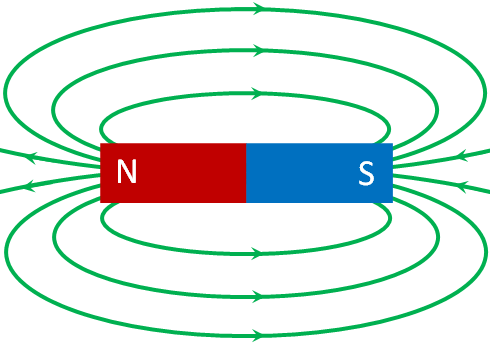
Magnetic field is stronger near the poles, where the magnetic field lines are closer to each other.
Electric currents and magnetic field
If there is a wire that carries current, there is a magnetic field around it.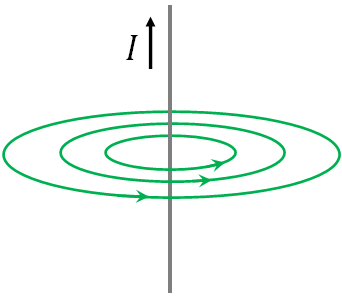
$B=\dfrac{\mu_0 I}{2\pi r}$
where $r$ is the perpendicular distance between the point and the current carrying wire, and $\mu_0=4\pi\times 10^{-7} T.m/A$, a constant called the permeability of free space.The above equation is called Biot-Savart law.
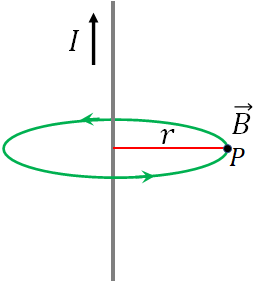
Direction of the magnetic field is determined by the right hand rule: grasp the wire with your right hand so that your thumb points in the direction of the current, then your fingers will curl around the wire in the direction of the magnetic field.
In the figure, the current carrying wire is on the plane of the page. At the point $P$, the direction of the magnetic field is into the page by applying the right hand rule.
SI unit of magnetic field is tesla, $T$ that is same as $N/A.m$.
Force on an electric current in a magnetic field
If a current carrying wire is placed in a magnetic field, there is a force being exerted on the wire by the magnetic field. Magnitude of the force on the wire in a magnetic field $B$ is$F=I\ell B\sin\theta$
where $\ell$ is the length of the wire within the magnetic field and $\theta$ is the angle between the magnetic field and the current direction.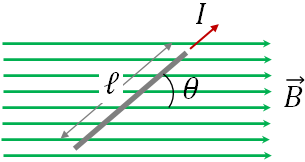
In the figure above, you can find that the direction of the magnetic force on the wire is into the page by the right hand rule.
A moving charge in a magnetic field
When an electric charge or a charged particle is moving in a magnetic field, the magnetic field exerts a force on the charge. We can derive an equation for the magnetic force on a charge by considering the force on a current carrying wire by a magnetic field as current is nothing but the motion of charge.When a current carrying wire is placed in a magnetic field, the magnitude of the force, $F$ on the wire by the magnetic field, $B$ is
$F=I\ell B\sin\theta$
If in a time interval, $t$, there is a charge $q$ pass by a given region of the wire, then the magnitude of the current is
$I=q/t$
Substituting this in the force equation:
$F=(q/t)\ell\, B\sin\theta$
If the charge $q$, travels a distance $\ell$ during the time $t$, then the speed of the charge is$v=\ell/t$
Solving for $\ell$,
$\ell=vt$
Substituting this in the force equation,$F=qvB\sin\theta$
This equation gives you the magnitude of the force on a charge or a charged particle of charge, $q$ in a magnetic field. Here $\theta$ is the angle between the magnetic field and the direction of velocity (i.e., the direction of motion) of the charge.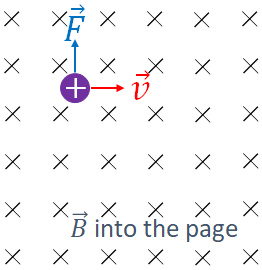
The direction of the magnetic force on a charge is given by another right hand rule: first stretch your fingers in the direction of the particle's velocity, then curl your fingers in the direction of the magnetic field, now your thumb points in the direction of the force if the charge is positive, or in the opposite direction to the thumb if the charge is negative.
If you substitute, $v=0$ in the above equation, you get $F=0$. That is the magnetic force on a charged particle is zero, when the charge is in rest. Also when, $\theta=0$, $\sin \theta=0$ and you will get $F=0$. That is the force is zero, when the charged particle is moving parallel to the magnetic field. The force is maximum when the direction of motion (or velocity) of the particle and the magnetic field are perpendicular to each other, because in this case $\theta=90^\circ$ and $\sin 90=1$, the maximum value of sine.
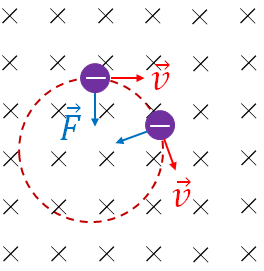
If a charged particle moves perpendicular to a uniform (constant in magnitude and in direction) magnetic field, then the path of the charged particle will be a circle. Since the charge is in circular motion, it has a centripetal force:
$F_c=\dfrac{mv^2}{r}$
where $r$ is the radius of the circle.The centripetal force is the net force on the charge. If the magnetic force is the only force acting on the charge, then the net force is the magnetic force and we have
$qvB\sin\theta=\dfrac{mv^2}{r}$
Since the magnetic field is perpendicular to the velocity of the particle, $\theta=90^\circ$, and $\sin\theta=1$, so we have$qvB=\dfrac{mv^2}{r}$
Solving for $r$, we get the radius of the circle:$r=\dfrac{mv}{qB}$
Note that magnetic force on a charged particle is always perpendicular to the velocity of the particle. Therefore, a magnetic force does not change the speed of a charged particle, but it only changes the direction of motion of the charged particle.Force between two parallel wires
If there are two parallel wires carrying currents close to each other, there exists a magnetic force between them. The magnitude of the force is given by$F=\dfrac{\mu_0 I_1I_2\ell}{2\pi d}$
where $I_1$ and $I_2$ are the magnitude of the currents in the wires, $d$ is the distance between the wires and $\ell$ is the length of the wire (s).
The wire 1 exerts a force on wire 2, which is $\vec F_{21}$ and the wire 2 exerts a force on the wire 1, $\vec F_{12}$. The forces are equal and opposite according to Newton's third law. You can find the magnitudes of the forces by the equation above.
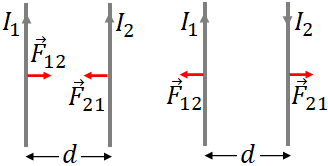
If the currents are in the same direction, then you can see that the two wires attract each other. So, the forces, $\vec F_{21}$ and $\vec F_{12}$ are toward each other. But if the currents are in the opposite directions, then the force is repulsive and the wires push each other away. So, $\vec F_{21}$ and $\vec F_{12}$ are away from each other.
Solenoids
A solenoid is a long coil of wire containing many loops (or turns). It acts like a magnet with one end is the north pole and the other is the south pole. Magnetic field (magnitude) inside a solenoid is$B=\dfrac{\mu_0NI}{\ell}$
where $I$ is the current through the solenoid, $N$ is the number of turns, and $\ell$ is the length of the solenoid.Electromagnet
If a piece of iron is placed inside a solenoid, the iron becomes a magnet. So, the resulting magnetic field inside the solenoid is now the sum of the magnetic field due to the current and that due to the magnet. The result is the magnetic field inside the solenoid increases tremendously, by several hundreds or thousands of time. A solenoid with an iron core is called an electromagnet. Electromagnets have lots of applications. They are used in electric circuit breakers, in door bells, in loudspeakers and in induction heating to name a few.
Ampere's law
Ampere's law relates the magnetic field around a closed path to the current passing through the surface enclosed by the path.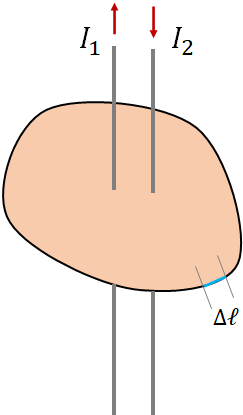
Suppose you have some current carrying wires and you are taking a closed path around the currents as shown in the figure. At any point around a current, there is a magnetic field. Now, split the path into small segments of length Δℓ and find the component of the magnetic field parallel to each of the segments, which is B||. Now, multiply the B|| with Δℓ for each segment and add all of them. This sum is equal to $\mu_0$ times the net current enclosed by the closed path. This is what is Ampere's law. i.e.,
$\Sigma B_\parallel \Delta \ell=\mu_0 I_{encl}$
where $I_{encl}$ is the net current passing through the surface enclosed by the path.
Ampere's law is equivalent to the Gauss's law in electrostatics. It is very useful to find the magnetic field of current carrying wires of any shape (not only straight wires). We can also find the magnetic field inside a solenoid by using Ampere's law.
Torque on a current loop
When a closed loop of coil of conducting wire carrying a current is placed in a magnetic field, the magnetic force on the coil can exert a torque on the coil.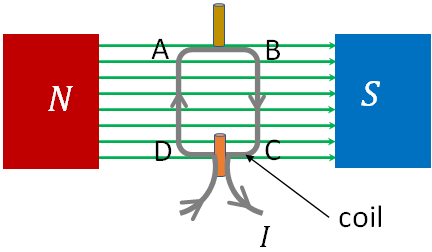
$F=I\ell B\sin 90=I\ell B$
where $\ell $ is the length of the side AD.
On section BC, the current flows from top to bottom. So, the magnetic force on this section is out of the page. Since the coil is a rectangle, AD = BC, therefore, the magnitude of the force on this section is same as that on the section AD but in the opposite direction. So, there are two equal and opposing forces on the coil, which produce a torque on the coil. Note that there are no forces on the sections AB and DC of the coil as the current in these sections are parallel to the magnetic field.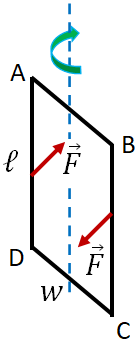
$\tau=\dfrac{w}{2}\,F+\dfrac{w}{2}\,F=wF$
where $w$ is the width of the coil that is the length of the sides AB and DC.Substituting, $F$ in the equation, we get
$\tau=wI\ell B$
The product of $w$ and $\ell$ is just the area of the coil (rectangle), $A$. So, substituting, $w\ell=A$,
$\tau=IAB$
This is the equation for the torque on a coil of one turn in a magnetic field.If the coil has more than one turns, then torque on each coil will add up. So if there are $N$ turns in the coil, then the torque on the coil is
$\tau=NIAB$
Mass spectrometer
Mass spectrometers are used to measure the masses of atoms.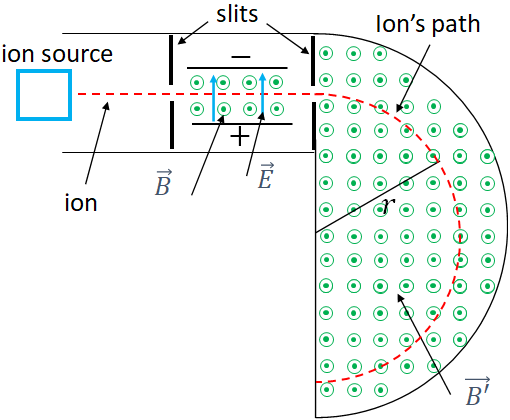
$F_1=qE$, where $q$ is the charge on the ion.
Also, in the region between the plates, there is a magnetic field, $\vec B$ applied in a direction that is out of the plane of this page. This magnetic field creates a downward magnetic force on the ions.The force on an ion by the magnetic field is$F_2=qvB$, where $v$ is the velocity of the ion.
So, there are two forces on an ion, an upward electric force and a downward magnetic force. Only the ions with certain speed can have the two forces balance, and those ions travel straight and pass through a second slit. All other ions will be deflected above or below the horizontal direction and are blocked by the slit.
Equating the electric and the magnetic forces,
$qE=qvB$
Solving for $v$,
$v=\dfrac{E}{B}$
Only the ions with this speed can pass through the second slit.
The region after the second slit is filled with a magnetic field, $\vec B'$,which is also directed out of the page. The positive ions entering this region are exerted by a magnetic force by the magnetic field. Since the ions travel perpendicular to the magnetic field, they follow a circular path in the clockwise direction. For an ion in circular motion, the magnetic force is the centripetal force as the magnetic force makes the ion to follow the circle, therefore
$qvB'=\dfrac{mv^2}{r}$
where $m$ is the mass of the ion.Dividing out $v$,
$qB'=\dfrac{mv}{r}$
Substituting $v=E/B$, from the previous equation and solving for $m$, we get
$m=\dfrac{qBB'r}{E}$
For a constant electric and magnetic field, mass of an ion depends on the radius, $r$ of the circular path of the ion. So, by measuring the $r$, we can find the mass of the ion.
